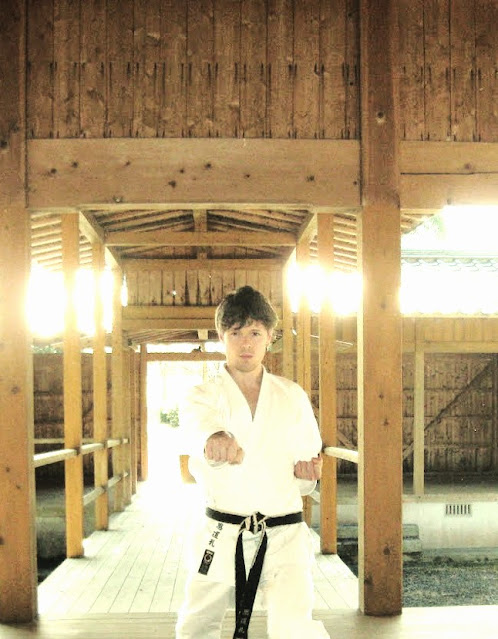This brief article will outline some key points pertaining to the most basic form of practicing 刻み突き (kizami-zuki) and 逆突き (gyaku-zuki) in stationary zenkutsu-dachi. This is, of course, is the most common Shotokan ‘isolation practice’ of basic 腰の回転 (KOSHI NO KAITEN): in general sonoba-kihon training. Overall, I hope that this post will be useful via analysis of this ‘base practice’, which underpins the freestyle kihon and, ultimately, optimal application in jiyu-kumite and self-defense . 押忍 ― AB.
1.0 Preparatory position:
Assume hidari zenkutsu-dachi with hidari gedan-barai rotating the hips into hanmi. From here slowly extend migi seiken chudan gyaku-zuki rotating the hips into shomen. Relax the breathing, sink into the seika tanden, and free/externalize your mind to the environment; that is, free reception to any stimuli.
1.1 Slow motion practice and basic details:
Slowly rotating into hanmi make hidari seiken jodan kizami-zuki targeting the jinchu. Then counter rotate into shomen making migi seiken chudan gyaku-zuki. For kizami-zuki push with the heel of the lead left foot utilizing the axis of the rear hip; furthermore, slightly bend the rear knee whilst rolling the upper thigh subtlety outward. For gyaku-zuki push with the heel of the rear right foot utilizing the axis of the front hip. Use the straightening of the rear leg to turn the hip around and forwards.
With both tsuki keep the front knee as stable as possible
with little or, ideally no movement. Also, keep the face and head set in place
and shisei (posture)—neck, backbone and pelvis—completely erect and aligned at
all times.
Subtlety exhale on each tsukiwaza reserving around 30
percent of breath in the hara. These exhalations should nearly be
imperceptible.
1.2 Basic details of full speed practice:
If any points in the slow motion practice are sacrificed, it
means one is moving too fast for their technical ability; thus, training will
actually reduce one’s skill and by grooving bad habits into basic form.
Accordingly, aim for precision gradually building speed
without cheating yourself. Both tsuki, especially the kizami-zuki must be full
and possess kime. An important note here is the connection to ukewaza followed
by secondary waza. Kime must always be achieved in every waza.
The kiai when used must be done and applied correctly. ‘Kiai
with tsukiwaza, keriwaza and uchiwaza’ are short and sharp, in a single
syllable to concentrate power. Furthermore, they applied at the point of impact
when the respective waza begins to go through the respective target. In
traditional budo karate, theatrics have no place, thus a ‘poker face’
accompanies the kiai. Contrast this with sports karate where the dramatic
‘kabuki facial expression’ and the ‘fog horn kiai’ are now the norm.
Please take note about tachikata. Both feet in
zenkutsu-dachi must remain fully in contact with the floor with special
attention on the sokuto (sword foot) of the rear leg. Obviously, some people
with high arches cannot precisely achieve this aesthetically. But this doesn’t
matter in budo karate. What matters is the pressure to sokuto. Even with a high
arch and space under the foot: this waza can therefore still be
perfect.
Furthermore, the length of zenkutsu-dachi is the maximum
length without hindering a full and proper shomen, and the turning of the rear
foot beyond 45 degrees. Be sure to have the head of the front legs knee
directly above your toe tips with the front foot inverted one toe-width inward.
Naturally disallow the front knee to collapse inwards, but do not unnaturally
push it outwards. Imagine a triangle formed by the front knee/thigh and rear
legs outer hip joint when locked into shomen. This is the shime of the hips. In
addition to rotating the hips, the corresponding hip must be pushed slightly
forward with the corresponding tewaza. In sum, even when stationary ‘attack
with your stance’. If shomen cannot be fully achieved, one can slightly pull
back the head of the front knee; however, this must be carefully balanced to
avoid power loss and reduction of stability.
Lastly, besides correct stance, form, trajectory and strong
‘karada no buki’ (in this case, seiken) when moving fast “…concentrate on speed
as opposed to power”. In fact, try to use no conscious muscle contractions but,
rather, throw the fists out with maximum looseness and snap. This is utterly
imperative practice when training waza without a target. In this way, optimal
movement will be developed, and individual muscular (maximum) capacity can be
exceeded. In addition to increasing speed, power and fluidity, this makes one’s
waza harder to be detected by an opponent.
1.3 Generic practice routine/overview:
Practice One: 10 slow repetitions, one thrust per count.
Practice Two: 10 quick repetitions, one thrust per count with a kiai on the tenth and final waza.
Practice Three: 10 quick repetitions, both thrust per count with a kiai on the tenth and final gyaku-zuki.
Practice Four: 10 quick repetitions, both thrust per count with a kiai on every gyaku-zuki.
Practice Five to Eight: Repeat on the opposite side.
1.4 The criticality of 'level-up' practice:
Above this base training of kizami-zuki and gyaku-zuki there are numerous exercises. While we also do these waza in idokihon practice, beyond this it is absolutely essential to practice them from jiyu-dachi with jiyu na kamae: applying maximum TAI NO SHINSHUKU. In this regard, the most important training is: (1) Uchikomi practice on a partner or partners (such as a ‘line up’); (2) Full contact impact training on moving focus mitts, the sandbag, etcetera; and (3) Jiyu Kumite.
In sum, the basic training and freestyle training are
inseparable once one advances to high kyu and, certainly, at shodan and above.
Without the basic form of practice, one will never acquire the characteristic
kime that ‘makes karate’ karate. Likewise, without the thorough ‘freestyle
practice’ of waza, one will never be able to make their respective actions
reliable in a freestyle context. Hence, “…the traditional waza will be nothing
more than a sub-effective relic”.
© André Bertel. Oita City, Japan (2023).

No comments:
Post a Comment